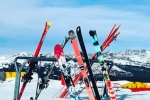Preventing Winter Sports Injuries

Almost 200,000 people were treated at hospitals, doctors' offices, and emergency rooms for injuries related to winter sports in 2018, according to the U.S. Consumer Product Safety Commission. This figure includes:
- 76,000 injuries from snow skiing
- 53,000 injuries from snowboarding
- 48,000 injuries from ice skating
- 22,000 injuries from sledding and tobogganing
Common winter sports injuries include sprains, strains, dislocations, and fractures. Many of these injuries happen at the end of the day, when people overexert themselves to finish that one last run before the day's end.
Most winter sports injuries can easily be prevented if participants prepare for their sport by keeping in good physical condition, staying alert, and stopping when they are tired or in pain.
--
Youth Ski and Snowboard Injury Prevention
By Catherine A. Logan MD, MBA, MSPT and Patrick S. Buckley, MD
Skiing and snowboarding are increasingly popular activities for both children and adolescents. Injury rates range between 3.9 and 9.1 injuries per 1000 skier days, 1 with injuries ranging from severe (head, neck and spine injuries) to minor (sprains and strains). In an investigation of injury patterns and severity of 1655 children skiers treated at trauma centers in the United States, skiers were more likely to sustain face, chest, and lower extremity injuries than their snowboarder counterparts.2 Injuries on the slopes are likely multi-factorial and may be due to improper equipment, inadequate skill, poor trail or park conditions, fatigue, and/or collisions. Proper Equipment Collisions and falls constitute a significant portion of trauma, and are commonly associated with excessive speed, adverse conditions, overconfidence or lack of fear. Avoiding head injury and enforcing helmet use should be of importance for all children on the slopes. The helmet must be designed for skiing and properly fit, it should not be a helmet designed for another sport. Always replace the helmet if it has sustained a significant blow. The skier’s equipment, including boots, bindings, and skis, should be outfitted to match their height, weight, level of experience, and boot size. Poorly functioning or poorly fit equipment is a frequent cause of injuries.
Technique & Terrain Formal instruction focusing on strategies of collision avoidance, fall training and overall mountain safety can minimize lower extremity trauma. Education on slope conditions and the effect of light and shadowing on terrain will also help reduce risk. Both skiers and snowboarders should be aware of the conditions as well as the level of difficulty of the terrain and make the appropriate adjustments to avoid injury while still enjoying the day.
Fatigue
In the setting of a compressed one-week ski trip as opposed to a series of weekend day trips, it is tempting to overdo things on the first few days to make the best of your investment. However, as muscles and attention fatigue, children become tired and have an elevated risk for collisions and falls Take breaks and incorporate other mountain activities such as tubing or sled rides to change it up. Ensure children drink plenty of fluids and eat hearty food throughout.
Après Ski Stretching is one of the best ways to help your body recover from a long day on the slopes. A series of yoga-inspired flow and holds can be done as a family to avoid sore muscles the next day. HERE is a recommended series. The goal of this après ski session is to improve the circulation of blood to your muscles to enable them to recover and repair. Emphasis is on stretching the muscles of the torso/low back, glutes, quadriceps and calves.
- Meyers MC, Laurent CM, Jr., Higgins RW, Skelly WA. Downhill ski injuries in children and adolescents. Sports Med. 2007;37(6):485-499.
- Polites SF, Mao SA, Glasgow AE, Moir CR, Habermann EB.







